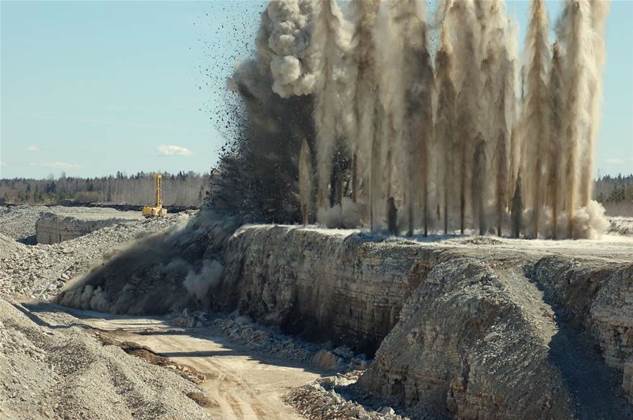Australia's miners will soon be taking advantage of sophisticated physics engines found in computer games to improve the accuracy of explosives used to blast ore from the ground.

Today iTnews studies the rise of technology systems that underpin rock blasting in open pit and underground mine operations, such as predictive modelling, radio-controlled detonation, real-time monitoring and post-blast data analysis.
Across the blast lifecycle, IT systems are used to record, manage and analyse data being generated.
Poor blasting execution not only has negative economic consequences, but is also a safety and environmental hazard, with ground vibration, airblast overpressure, dust, fumes, and the potential for flyrock all important considerations for miners.
Blast engineers are ideally trying to predict three outcomes in blast design: fragmentation (the size distribution of the blasted material), movement (where the grade and waste will end up), and environmental consequences, according to W.H. Bryan Mining and Geology Research Centre (BRC) principal mining engineer Alan Cocker.
Cocker told iTnews that although three-dimensional blast movement models have been in development "over a number of years, [they] have never achieved their potential for site use".
However, he believed that could change via joint research works between BRC and the federal government's CRC ORE cooperative research centre.
"With the massive increases in computer power over recent years and the advent of the sophisticated physics engines used in the computer games industry, a workable three dimensional movement model that uses crucial elements of real physics is in reach," he said.
Open source physics engines such as Bullet, which have previously been used for 3D collision detection and soft body/rigid body dynamics within video games (Grand Theft Auto IV, Red Dead Redemption) and video effects in movies (Shrek 4, Sherlock Holmes), are now being adapted to the resources industry.
"Clearly, there is a difference between Joe Blow fragging and nuking aliens one by one and 130,000 uniform blocks in motion, each colliding with one another," Cocker said.
"What we hope to offer the mining industry is a modelling tool that can predict ore movement to minimise the twin evils of loss and dilution. You need to know where the good stuff ends up after the blast, or you’ll be processing waste and dumping ore! In a perfect world ore would be green and waste red (or black). Unfortunately they can look identical, and dig lines are often laid out as though the stuff hasn’t moved at all."
Blast design
Predictive blast fragmentation models used in the past have typically been either numerical or empirical, Cocker said.
Numerical models such as discrete element method (DEM), he noted, are onerous to configure and demanding of resources — both computing and human — and are generally not appropriate for operational use at mines.
"The problem with empirical models, by contrast, is that they tend to operate at a scale too coarse to give results useful for optimisations," he added, noting typical Kuz-Ram-based fragmentation models [pdf] (widely used to estimate fragmentation from blasting) assume homogeneous geology (the same type of materials) throughout a blast.
CRC ORE's integrated blasting software, SMI BlastOre, is being developed to provide modelling support for existing blast design editors, such as JKSimBlast, incorporating a 3D blast movement model based on a physics engine.
"In many ways SMI BlastORE is just a further step on the path towards a complete blast design and modelling package; it does not design blasts itself, but instead supports the blast design editor by providing an advanced predictive modelling toolkit," Cocker said.
"What is needed ultimately is a fully featured and integrated blast design (IBD) package with a plugin interface to support current and future predictive blast performance models; the IBD should be fully 3D and fully responsive to geological and geotechnical variation."
Cocker noted mining companies are ultimately seeking ease of use and integration.
"What they really want is a big 'GO' button in their chosen mine planning software to instantly access and model all the available data, pasting the best possible blast design back into the host software," he said.
"As part of this process an ideal IBD would also supply field equipment, such as autonomous drills and smart explosives trucks, with the required menus in order to implement the ideal design automatically."
Read on for how miners are using radio networks and video for blast accuracy...





.png&h=140&w=231&c=1&s=0)



.png&w=100&c=1&s=0)

 Digital Leadership Day Federal
Digital Leadership Day Federal
 Government Cyber Security Showcase Federal
Government Cyber Security Showcase Federal
 Government Innovation Showcase Federal
Government Innovation Showcase Federal
 Digital NSW 2025 Showcase
Digital NSW 2025 Showcase












_(1).jpg&h=140&w=231&c=1&s=0)



